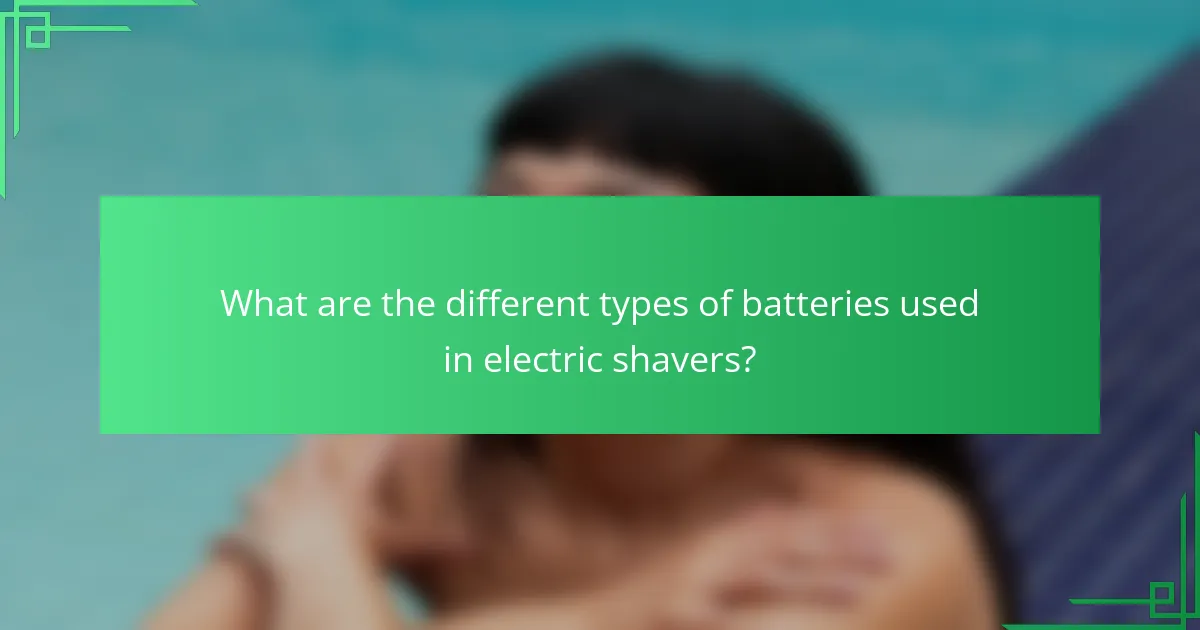Battery capacity is a critical factor that directly affects the efficiency of electric shavers. Higher capacity batteries, such as those rated at 4500 mAh, provide longer operational times and better performance compared to lower capacity options like 2000 mAh batteries. Electric shavers typically utilize three types of batteries: nickel-cadmium (NiCd), nickel-metal hydride (NiMH), and lithium-ion (Li-ion), each with distinct advantages and disadvantages. Users can enhance shaver efficiency by maintaining optimal battery levels, using appropriate power settings, and performing regular maintenance, such as cleaning the blades. Understanding these elements helps ensure a more effective and uninterrupted shaving experience.

How Does Battery Capacity Influence Electric Shaver Efficiency?
Battery capacity directly influences electric shaver efficiency by determining the duration and power of usage. Higher capacity batteries provide longer operational time before needing a recharge. This extended usage allows for more efficient shaving sessions without interruptions. Additionally, a larger battery can sustain higher power output, resulting in better performance. For example, electric shavers with 4500 mAh batteries usually offer a more powerful and consistent shave compared to those with 2000 mAh batteries. Therefore, battery capacity is crucial for maximizing the efficiency and effectiveness of electric shavers.
What is battery capacity and why is it important for electric shavers?
Battery capacity refers to the amount of electrical energy a battery can store, measured in milliampere-hours (mAh). It is crucial for electric shavers because it determines how long the device can operate on a single charge. Higher battery capacity allows for longer usage times between charges. This is particularly important for users who require multiple shaving sessions or travel frequently. A battery with low capacity may lead to shorter run times, resulting in inconvenience. For instance, a shaver with a capacity of 2000 mAh can run for several hours, while one with 500 mAh may only operate for a fraction of that time. Therefore, understanding battery capacity helps consumers choose effective and reliable electric shavers.
How is battery capacity measured in electric shavers?
Battery capacity in electric shavers is measured in milliampere-hours (mAh). This unit quantifies the amount of electric charge a battery can store. Higher mAh ratings indicate longer usage times before recharging is necessary. For example, a shaver with a 1500 mAh battery can run longer than one with a 600 mAh battery. Manufacturers often provide this information in product specifications. This measurement helps consumers gauge the performance and efficiency of electric shavers.
What are the typical battery capacities found in electric shavers?
Typical battery capacities in electric shavers range from 600 mAh to 1500 mAh. Most cordless electric shavers utilize lithium-ion batteries. These batteries provide efficient power and longer usage times. A capacity of 600 mAh typically allows for about 30 minutes of shaving. Higher capacities, like 1500 mAh, can extend usage to over an hour. The capacity affects the shaver’s runtime and charging frequency. Brands often specify battery capacity in product descriptions to inform users. This information helps consumers choose based on their shaving needs.
How does battery capacity affect the performance of electric shavers?
Battery capacity directly influences the performance of electric shavers. Higher battery capacity allows for longer usage time between charges. This results in consistent power delivery during shaving sessions. A shaver with a larger capacity can maintain speed and effectiveness throughout its operation. Conversely, a lower capacity may lead to reduced performance as the battery drains. For example, a shaver with a 4500 mAh battery can operate longer than one with a 1500 mAh battery. This difference affects how well the shaver can cut hair without interruption. Thus, battery capacity is crucial for optimal electric shaver performance.
What impact does battery capacity have on shaving time?
Battery capacity directly impacts shaving time. A higher battery capacity allows for longer usage before needing a recharge. For instance, a shaver with a 4500 mAh battery can operate for more than an hour on a single charge. In contrast, a lower capacity battery may only last 30 minutes. This extended runtime enables users to complete their shaving routine without interruptions. Additionally, electric shavers with larger batteries tend to maintain power consistency throughout the shave. This ensures a more efficient and effective shaving experience. Thus, battery capacity is crucial for determining how long an electric shaver can be used before recharging.
How does battery capacity relate to motor power and blade speed?
Battery capacity directly influences motor power and blade speed in electric shavers. Higher battery capacity allows for sustained motor power, which translates to consistent blade speed. For instance, a shaver with a 4500 mAh battery can maintain optimal performance longer than one with a 2000 mAh battery. This is crucial during extended use, where lower capacity may lead to diminished power and slower blade rotation. Studies show that electric shavers with larger batteries can perform efficiently for longer periods without overheating. Thus, battery capacity is essential for maintaining the efficiency of motor power and blade speed in electric shavers.
What are the benefits of higher battery capacity in electric shavers?
Higher battery capacity in electric shavers provides extended usage time between charges. This means users can shave multiple times without needing to recharge. Increased battery capacity also supports more powerful motors, enhancing cutting efficiency. Higher capacity batteries often result in faster charging times, reducing downtime. Additionally, they can maintain consistent performance throughout the battery’s life. This ensures a more reliable shaving experience. According to battery technology research, larger capacity batteries can improve overall device longevity and user satisfaction.
How does a higher battery capacity improve user experience?
A higher battery capacity improves user experience by providing longer usage time. This allows users to complete their grooming tasks without interruptions. For instance, an electric shaver with a 4500 mAh battery can last significantly longer than one with a 2000 mAh battery. Longer battery life means less frequent charging is required. Users can enjoy convenience and flexibility in their routines. Additionally, higher capacity batteries often maintain power consistency throughout the usage period. This ensures optimal performance during each shave. Overall, enhanced battery capacity directly contributes to a more satisfying and efficient grooming experience.
What advantages do long-lasting batteries provide for travel and convenience?
Long-lasting batteries offer significant advantages for travel and convenience. They reduce the need for frequent recharging, allowing users to maintain their devices over extended periods. This is particularly beneficial during long trips where access to power sources may be limited. Long-lasting batteries enhance portability by minimizing the weight and bulk of extra chargers. Users can enjoy uninterrupted usage of devices, such as electric shavers, during travel. Additionally, these batteries contribute to a more reliable performance, ensuring devices function optimally when needed. According to a study by the International Energy Agency, advancements in battery technology have led to improved energy density, which supports longer usage times.

What are the different types of batteries used in electric shavers?
Electric shavers commonly use three types of batteries: nickel-cadmium (NiCd), nickel-metal hydride (NiMH), and lithium-ion (Li-ion). NiCd batteries are known for their durability and ability to withstand many charge cycles. However, they suffer from memory effect, which can reduce their effective capacity over time. NiMH batteries have a higher capacity than NiCd and are less prone to memory effect. They are often preferred for their longer run time. Li-ion batteries are the most advanced option. They offer high energy density, longer lifespan, and no memory effect. As a result, Li-ion batteries are increasingly used in modern electric shavers for optimal performance.
What are the common battery types found in electric shavers?
Common battery types found in electric shavers include lithium-ion and nickel-metal hydride. Lithium-ion batteries are prevalent due to their high energy density and lightweight nature. They typically provide longer run times and faster charging capabilities. Nickel-metal hydride batteries, while heavier, offer reliable performance and are often more affordable. Both battery types are rechargeable and designed to withstand multiple charging cycles. The choice of battery affects the overall efficiency and convenience of the electric shaver.
What are the pros and cons of lithium-ion batteries in electric shavers?
Lithium-ion batteries in electric shavers offer several advantages and disadvantages. One major pro is their high energy density, which allows for longer usage times. Lithium-ion batteries typically provide consistent power output until depletion. They also have a low self-discharge rate, maintaining charge for extended periods when not in use. Additionally, they are lightweight, contributing to the overall portability of electric shavers.
On the downside, lithium-ion batteries can be expensive compared to other battery types. They may also have a limited lifespan, often requiring replacement after a few hundred charge cycles. Furthermore, they can be sensitive to extreme temperatures, which may affect performance. Lastly, improper disposal poses environmental concerns due to toxic materials.
How do nickel-metal hydride batteries compare to lithium-ion batteries?
Nickel-metal hydride (NiMH) batteries generally have a lower energy density compared to lithium-ion (Li-ion) batteries. NiMH batteries typically offer about 60-70 Wh/kg, while Li-ion batteries provide around 150-250 Wh/kg. This means that Li-ion batteries can store more energy in a smaller and lighter package.
NiMH batteries have a higher self-discharge rate, losing about 20% of their charge per month. In contrast, Li-ion batteries lose about 5% per month. NiMH batteries also have a shorter lifespan, typically lasting 500-1000 charge cycles, while Li-ion batteries can last 1000-2000 cycles.
Furthermore, NiMH batteries perform poorly in cold temperatures, whereas Li-ion batteries maintain efficiency across a wider temperature range. This performance difference makes Li-ion batteries more suitable for applications requiring compactness and efficiency, such as electric shavers.
How does battery technology impact electric shaver efficiency?
Battery technology significantly impacts electric shaver efficiency by determining power output and runtime. Advanced battery types, such as lithium-ion, provide higher energy density. This allows shavers to operate longer on a single charge compared to older nickel-cadmium batteries. Efficient battery management systems enhance performance by optimizing energy usage during shaving. High-capacity batteries reduce charging time and increase user convenience. Studies show that shavers with modern batteries can maintain consistent power levels throughout their use. This results in a smoother shaving experience and less irritation. In summary, improved battery technology directly correlates with enhanced electric shaver efficiency.
What advancements in battery technology are enhancing electric shaver performance?
Advancements in battery technology are significantly enhancing electric shaver performance. Lithium-ion batteries are now commonly used in electric shavers. They offer higher energy density compared to older nickel-cadmium batteries. This results in longer usage times between charges. Fast charging capabilities have also improved, allowing shavers to be ready for use in shorter periods. Additionally, smart battery management systems optimize power consumption. This ensures efficient energy use during operation. Recent developments include the integration of graphene batteries. These batteries provide faster charging and increased longevity. Overall, these advancements lead to more efficient and reliable electric shavers.
How do charging times vary between different battery types?
Charging times vary significantly between different battery types. Lithium-ion batteries typically charge faster than nickel-cadmium batteries. For instance, lithium-ion batteries can reach full charge in 1 to 3 hours. In contrast, nickel-cadmium batteries may take 5 to 8 hours to fully charge. Lead-acid batteries also have longer charging times, often requiring 8 to 12 hours for a complete charge. The chemistry of the battery affects these charging times. Lithium-ion batteries have higher energy density and efficient charging cycles. This results in quicker charging compared to other types.

How can users maximize electric shaver efficiency related to battery capacity?
Users can maximize electric shaver efficiency related to battery capacity by regularly charging the device. Keeping the battery fully charged ensures optimal performance. Users should avoid letting the battery completely discharge. This practice can extend the overall lifespan of the battery. Additionally, using the shaver with the appropriate power settings can improve efficiency. High power settings may drain the battery faster, while lower settings can conserve energy. Regular maintenance, such as cleaning the blades, also contributes to better efficiency. Clean blades allow the shaver to operate smoothly, reducing strain on the battery. Following these practices can result in a more efficient shaving experience.
What maintenance tips can improve battery life in electric shavers?
Regularly cleaning electric shavers enhances battery life. Dirt and hair can hinder performance and drain the battery faster. Ensure to remove the shaving head and clean it with a brush after each use. Rinse the head under running water if the shaver is waterproof. Lubricate the blades with a few drops of oil periodically. This reduces friction and helps maintain efficiency. Avoid overcharging the battery, as this can lead to reduced capacity over time. Charge the shaver only when necessary and unplug it once fully charged. Storing the shaver in a cool, dry place also helps preserve battery health. Following these tips can extend the lifespan of the battery significantly.
How should users store their electric shavers to protect battery health?
Users should store their electric shavers in a cool, dry place to protect battery health. High temperatures can degrade battery performance and lifespan. Humidity can lead to corrosion and damage. It’s advisable to keep the shaver away from direct sunlight. Storing the shaver in its original case can provide additional protection. Ensure the battery is charged to about 50% before storage to prevent deep discharge. Regularly check the shaver for any signs of battery swelling or leakage. Proper storage practices can significantly extend the overall life of the battery.
What are the best practices for charging electric shavers to extend battery lifespan?
Charge electric shavers only when the battery is low. This practice helps prevent deep discharges that can damage lithium-ion batteries. Avoid leaving shavers plugged in for extended periods after reaching full charge. Overcharging can lead to reduced battery capacity over time. Use the charger that comes with the shaver for optimal voltage. Using third-party chargers may not provide the correct power levels. Store the shaver in a cool, dry place when not in use. Extreme temperatures can negatively affect battery performance. Regularly clean the shaver to ensure efficient operation, which can help maintain battery health. Following these practices can significantly extend the battery lifespan of electric shavers.
What common issues arise with electric shaver batteries and how can they be resolved?
Common issues with electric shaver batteries include reduced charge retention, overheating, and physical damage. Reduced charge retention occurs when batteries age or are not properly maintained. Regular cleaning and proper charging practices can help mitigate this issue. Overheating can happen due to prolonged use or malfunctioning components. Allowing the shaver to cool down between uses can prevent overheating. Physical damage may result from dropping the shaver or exposure to moisture. Using a protective case and keeping the shaver dry can reduce the risk of damage. Regularly replacing old batteries is also essential for maintaining optimal performance.
What are the signs of a failing battery in an electric shaver?
A failing battery in an electric shaver shows several signs. The shaver may not hold a charge for long periods. Users might notice reduced power during operation. The shaver may take longer to fully charge. It could also fail to turn on after charging. Inconsistent performance is another indication. The battery may swell or show physical damage. Finally, the shaver may emit unusual sounds when in use. These signs suggest that the battery is no longer functioning optimally.
How can users troubleshoot battery-related problems in electric shavers?
Users can troubleshoot battery-related problems in electric shavers by following a systematic approach. First, check if the shaver is charged. A fully charged battery typically lasts for about 60 minutes of use. If the shaver does not turn on, inspect the charging cable and adapter for damage. A faulty charger can prevent the battery from receiving power. Next, clean the shaver’s battery contacts. Dirt or debris can impede the charging process.
If the battery still does not hold a charge, consider replacing it. Lithium-ion batteries, commonly used in electric shavers, have a lifespan of about 2-3 years. Lastly, consult the user manual for specific troubleshooting steps related to your model. Following these steps can help identify and resolve battery-related issues effectively.
The main entity of the article is electric shaver efficiency, which is significantly influenced by battery capacity. The article explores how battery capacity, measured in milliampere-hours (mAh), determines the duration and power of electric shaver usage, affecting performance and shaving time. It details the types of batteries used in electric shavers, their advantages and disadvantages, and how advancements in battery technology enhance efficiency. Additionally, it provides maintenance tips for maximizing battery life and troubleshooting common battery-related issues.